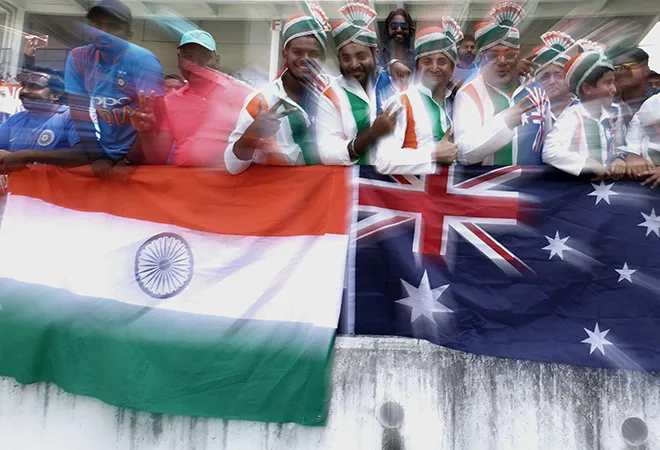
The historic win of Narendra Modi in the 2019 Indian elections has set a new narrative in Indian politics, where aspirational India has chosen the BJP government to write the destiny for a New India. If Modi 1.0 was about hope and promise, Modi 2.0 is about performance and delivery.
For Australia–India ties, this win is a moment of opportunity for Australia to reach out. To let India know, Australia wants to solidify its bilateral architecture (government, business and people-to-people led) with India through improved business and strategic ties. Scott Morrison should consider focusing on establishing a personal equation with Narendra Modi, something very similar to global leaders like Japan’s Shinzo Abe and Israel’s Benjamin Netanyahu. The congratulatory call of Morrison to Modi post the election win, and the invitation he received from Modi to visit India, is an opportunity that shouldn’t be missed, noting the friendship between the two countries and the importance of the Indian community in Australia. Morrison’s engagement with Modi’s personal diplomacy can open new avenues for cooperation and collaboration.
Morrison’s engagement with Modi’s personal diplomacy can open new avenues for cooperation and collaboration.
Australia may recognise that it cannot engage New India, with its old ways. It needs to be prompt and proactive, shedding off the old cyclical ways of engagement synonymous with roller coaster rides. There are enough countries today competing for India’s attention, which offers a fertile ground for businesses to expand because of the enormous opportunities. By 2025, one-fifth of the world’s working-age population will be Indian. By 2030, there will be over 850 million internet users in India. By 2035 India’s five largest cities will have economies of comparable size to middle income countries today.
The India Economic Strategy (IES 2035), which was released last year by the Australian government, is an ambitious plan to transform Australia’s economic partnership with India out to 2035. India has commissioned a reciprocal strategy chaired by
Ambassador Anil Wadhwa, who is authoring the Australia Economic Strategy for the Indian government, which is likely to be released later this year. The targets set in the IES 2035 are to make India a stronger economic partner and this should be driven by specific actions, agenda and timelines. This is pertinent as Australia is increasingly aware of its economic exposure and potential vulnerability to China.
Narendra Modi asserted in his first speech post win, that India needs to weave its regional aspirations with its national ambitions. The development gap that exists across different States in India, asks for a coherent policy and support, which Modi has promised to deliver. Its focus on individual states is based on the belief that prosperity and growth for all states, will automatically lead to India’s growth as a whole. During the 2019 elections, BJP and its allies got more than 50% of the votes in 16 states making it an unmatched formidable force. It strongly believes that only when Team India, comprising the Union government, state governments and local governments, works in a constructive combination of cooperation and competition that India will transform. A rising aspirational New India demands modern-day goods and services — in education, agriculture, energy, resources, healthcare, financial services, infrastructure, science and innovation. Australia can be India’s development anchor by energising ministerial engagements on these priority sectors and aligning itself with India’s goals. Communication, collaboration and consistency should define this relation now.
Australia can be India’s development anchor by energising ministerial engagements on these priority sectors and aligning itself with India’s goals.
Despite years of negotiations, a
Comprehensive Economic Cooperation Agreement (CECA) remains elusive. The negotiation for the
CECA between Australia and India started in 2011 to provide a boost to trade and investments between the countries. However, both sides have yet to resolve a number of issues; an agreement of this nature is always a challenge between countries, particularly when they are at different levels of development. Hence, Australia should look for ways to focus on securing some of the objectives of the
CECA with India through the
Regional Comprehensive Economic Partnership (RCEP). RCEP aims to create a free trade zone of 10 Asean nations and Australia, China, India, Japan, South Korea and New Zealand. This means a zero-customs duty zone in a geography that contributes 34% of global gross domestic product (GDP) and 40% of world trade. The region is also home to almost half of the world’s population.
Australia and India are situated in the most dynamic region of the Indo–Pacific that is the center of economic and strategic gravity today. The region has featured heavily in recent Australian strategic discourse, especially since the release of the 2013 defence white paper and the 2017 foreign policy white paper. The initiation of a 2+2 and new trilaterals have bolstered the strategic content of engagement. Military-to-military contact has also increased with the AUSINDEX naval and Australia Hind army exercises, Australian participation in India’s Milan exercise, regular port visits, and staff talks. With S. Jaishankar, former Foreign Secretary as the new External Affairs Minister who also worked in support of broadening of India’s maritime diplomacy by reaching out to the Asia-Pacific region and the Quad dialogue involving India, Japan, US and Australia was conducted during his stint as the Foreign Secretary in 2017 will clearly offer new insights. He has been responsible for implementing PM Modi’s foreign policy vision into actionable strategy. China’s dominance on maritime security and freedom of navigation in this Indo–Pacific region have strengthened the need for greater maritime cooperation between the two nations.
Australia needs to move fast, not just as a supplier, but also as a partner and enabler in India’s growth story.
Closer collaboration between Australia and India could also come from Australia’s support for India’s membership of
Asia-Pacific Economic Cooperation (APEC). APEC is a free trade agreement among 21 Pacific Rim member economies to which India is keen to be a member of. India’s absence from APEC is an anomaly, which should be fixed. India wants to be identified as a rule maker on the world stage; Narendra Modi wishes to position India in a leading role rather than just a balancing force globally. Australia and India can be partners in forging regional institutions in the Indo-Pacific that can give peace and stability to the region.
Narendra Modi has started his second stint with a 1,000-day agenda that will run up to the first half of 2022, the 75th anniversary of India’s Independence. Building strong international relations, making global friends and prioritising key sectors is high on the agenda for Modi 2.0 as he seeks to fulfill his promise of creating a “New India.” India is looking for solutions driven by high-end technology to address the country’s pressing problems. Can Australia tie its competitive advantages with India’s priorities? Australia needs to move fast, not just as a supplier, but also as a partner and enabler in India’s growth story. The opportune moment is now.
The views expressed above belong to the author(s). ORF research and analyses now available on Telegram! Click here to access our curated content — blogs, longforms and interviews.



 The historic win of Narendra Modi in the 2019 Indian elections has set a new narrative in Indian politics, where aspirational India has chosen the BJP government to write the destiny for a New India. If Modi 1.0 was about hope and promise, Modi 2.0 is about performance and delivery.
For Australia–India ties, this win is a moment of opportunity for Australia to reach out. To let India know, Australia wants to solidify its bilateral architecture (government, business and people-to-people led) with India through improved business and strategic ties. Scott Morrison should consider focusing on establishing a personal equation with Narendra Modi, something very similar to global leaders like Japan’s Shinzo Abe and Israel’s Benjamin Netanyahu. The congratulatory call of Morrison to Modi post the election win, and the invitation he received from Modi to visit India, is an opportunity that shouldn’t be missed, noting the friendship between the two countries and the importance of the Indian community in Australia. Morrison’s engagement with Modi’s personal diplomacy can open new avenues for cooperation and collaboration.
The historic win of Narendra Modi in the 2019 Indian elections has set a new narrative in Indian politics, where aspirational India has chosen the BJP government to write the destiny for a New India. If Modi 1.0 was about hope and promise, Modi 2.0 is about performance and delivery.
For Australia–India ties, this win is a moment of opportunity for Australia to reach out. To let India know, Australia wants to solidify its bilateral architecture (government, business and people-to-people led) with India through improved business and strategic ties. Scott Morrison should consider focusing on establishing a personal equation with Narendra Modi, something very similar to global leaders like Japan’s Shinzo Abe and Israel’s Benjamin Netanyahu. The congratulatory call of Morrison to Modi post the election win, and the invitation he received from Modi to visit India, is an opportunity that shouldn’t be missed, noting the friendship between the two countries and the importance of the Indian community in Australia. Morrison’s engagement with Modi’s personal diplomacy can open new avenues for cooperation and collaboration.
 PREV
PREV


